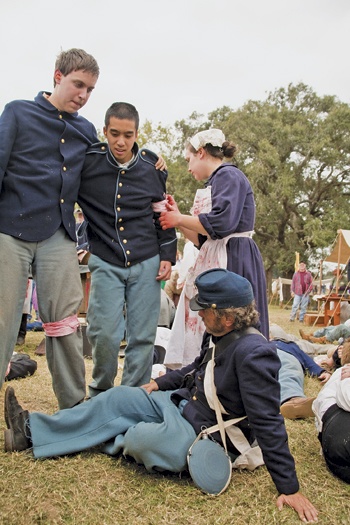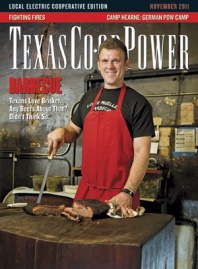Rebekah Cariker, Confederate matron of nurses, leans over a wounded man and whispers, “Come on, give ’em a good show!”
She then turns to a lingering soldier and orders: “Go get me some more wounded!”
The battlefield of the real War Between the States would’ve been combed already, but Cariker’s command signals the need for more players to please the crowd at what is one of Texas’ most popular Civil War re-enactment events: the Civil War Weekend at the Historic Liendo Plantation. Held annually the weekend before Thanksgiving—it’s scheduled for November 19-20 this year—the re-enactment is expected to draw more than 2,000 spectators to the East Texas town of Hempstead.
Through the lens of history, it wasn’t that long ago that soldiers trod the ground here: During the Civil War, Col. Leonard W. Groce’s Liendo Plantation was home to Camp Groce—the first permanent Confederate military prison west of the Mississippi River. And the plantation was the site of cavalry and infantry training camps and a hospital.
So this re-enactment, as far as theatrics go, keeps it real. At an operating platform near Cariker, Major Jack “Doc” Thomason describes a typical procedure while children exclaim “Ick!” at “amputated” limbs piled underneath.
From the grass drift the mournful tunes of the “hurt” and “dying.” Some roll to-and-fro, murmuring “It’s so cold,” as a chaplain makes his way among them, Bible in one hand, coins used to weigh eyelids with eternity’s sleep in another. Cariker, too, makes her own rounds through the grass, bestowing grace now, rather than orders, her bleached apron growing ruddy from “blood”—red food coloring.
Statewide, at about a dozen such events, an estimated 1,000 to 1,500 Civil War re-enactors are divided into about 20 groups. Of that figure, only a few hundred women partake, assuming such roles as officers’ wives and vivandières, a French term for women who accompanied troops in assistance roles. Only a handful of female re-enactors take on nursing personas. But caretaking is Cariker’s calling. Sure, the re-enactments are fake. But her passion is real.
“When I was 10, we were at Liendo, and I walked right up to Doc and told him I wanted to help him,” Cariker says. Thus began a mentorship with Thomason, a former Army medic who served in Vietnam and who plays Doc, a Confederate sawbones. Grinning, Cariker adds, “I almost threw up at one of his demonstrations, and he’s never let me live it down.”
Cariker says Thomason “has taught me everything related to 1860s medicine that I know, and he’s inspired me to continue my medical education.”
Cariker also has drawn inspiration from her father, a 22-year local firefighting veteran, and her late grandmother, who was a nurse. Cariker spends the time between re-enactment events teaching emergency medical technician (EMT) basics and working as an EMT-intermediate for a 911 service while training for EMT-paramedic certification and preparing for nursing school.
Shortly after Thomason appointed Cariker the matron of nurses, “I had one of those moments when the sky parted and beams of light came down,” she playfully shares. “I realized I could do this in real life, and I knew that, through nursing, I could really make a difference.”
Suddenly, eyes twinkling, Cariker’s attention shifts to the surgical platform where a thin-boned soldier lies ready for Thomason’s examination. “Oh, watch this!” she says, with a nudge and a wink. “This is Doc’s favorite part.”
Basking in the attention of the growing audience, Thomason performs living history, delivering well-timed theatrics, finally dramatically stuttering, “But, but, you’re … you’re a girl!” The crowd roars appreciatively.
During the Civil War, however, it was no laughing matter when women served in battle, and historians still don’t know how many women disguised themselves as men to do just that. Instead, during this era of Clara Barton (Civil War nurse and founder of the American Red Cross), Dorothea Dix (superintendent of women nurses for the U.S. Army) and Florence Nightingale (the founder of modern nursing), nursing, not soldiering, gets the most credit for advancing the cause of women’s rights.
Here at Liendo, with only one medical demonstration, blue and gray litter the grass together, and Cariker and two other nurses treat them all. In reality, women would have been miles away from the front lines at a general hospital, Cariker says. “But Doc discovering the female solider, that sort of thing did happen sometimes,” she continues, throwing his performance an appreciative smile.
The camaraderie between Cariker and Thomason is part of what makes re-enactment circuits special. And, Cariker stresses, it allows her and her own family—her four brothers are re-enactors—to maintain close ties. So central a role does re-enacting play in their family life, explains Cariker’s mother, Deborah Deggs Cariker, that she and others resurrected the 15th Texas Cavalry Co. A from Civil War days. The re-enactment unit performs in Texas, including at Liendo, and in other states.
Rebekah Cariker says she looks forward to the role her unit plays in special church services each year at the Liendo Plantation. “Most re-enactment events include Sunday services, rain or shine,” she explains. “Liendo’s nondenominational services are held with three units taking turns hosting them, and since my father is a licensed minister, every third year is his turn.”
She smiles. “But the best part is that the hymns are sung a cappella, and most years we hold hands and sing ‘Amazing Grace.’ ”
And afterward, when the hymns fade and the operating platform has been disassembled, Rebekah Cariker returns to her everyday life, where she prepares to help others overcome dangers, toils and snares. For real.
——————–
Mary O. Parker, a freelance writer, lives in Smithville.


